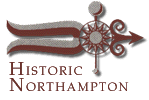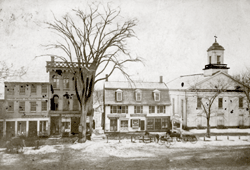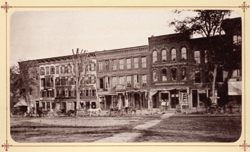
Bridge Street Cemetery Northampton Architecture Historic Markers 
|


Shop Row
 |
| Shop Row or Merchants’ Row as seen from the Warner House c. 1839 |
Until the mid eighteenth century, Northampton was primarily a market town, with few commercial establishments. The first shop to open on “Merchants’ Row,” directly across Main Street, was an apothecary established in 1769 by Levi Shepherd. Benjamin Tappan soon followed with his goldsmith establishment, which he shared with Nathaniel Fowle, a tailor. His son, Lewis Tappan went on to become one of the founders of the American Anti-Slavery Society and the founder of the Dun and Bradstreet Company in New York.
 |
| Shop Row about the time of the Civil War |
After the Revolution, merchants and artisans from outside the region were drawn by Northampton’s growth as a commercial center. Silversmith Nathan Storrs and clockmaker Isaac Gere were joined by a host of furniture and cabinet-makers such as Ansel Goodrich and David Judd. Replacing local craft traditions, the tastes of New York, Philadelphia and Boston now set the standard.
 |
| By the 1880s, Northampton had become a regional emporium. |
By 1800, Northampton, like the rest of the young Republic, was no longer isolated but was increasingly linked to a growing network of commerce and communication. Enterprising shop owners and merchants, who had accumulated capital in trade, now began to invest in local manufactures, canals, and turnpikes. In the 1860s, the Civil War transformed the home front. Northampton mills and factories provided a steady stream of supplies to fuel the Union Army. After the war, expansion continued until the end of the century. Northampton produced consumer goods for a national mass market made possible by the expansion of America’s railroads. Silk, bicycles, cutlery, tools, stoves, sewing machines and toothbrushes all bore Northampton trademarks. Retail shops and services multiplied. The Victorian architectural character that defines Northampton today took shape during this period.
Contents Historic Northampton.